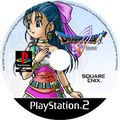Dragon Quest V (PS2)
For the original game released for the Super Famicom, see Dragon Quest V; for the remake released for Nintendo DS, see Dragon Quest V: Hand of the Heavenly Bride.
Changes to V originating from this version
Square Enix released a PlayStation 2 enhanced remake of Dragon Quest V on March 25, 2004, with first day sales of 722,000. As of April 2004, the game has sold over 1.5 million copies making it the top selling Dragon Quest remake game of all-time, and is available in Japan as a Square Enix Ultimate Hits title. The remake was developed by Dragon Quest VII art directors, ArtePiazza, who would go on to supervise remakes of nearly each title in the series. It features 3D graphics that are similar in style to Dragon Quest VII, but it utilizes the extra PlayStation 2 graphical capabilities. The Hero and his companions have to fight more monsters per battle in the PlayStation 2 remake than they did in the Super Famicom original, but the character limit on the party has been increased from three to four. Also, there were only 40 monsters available to the player's party in the Super Famicom version of Dragon Quest V due to ROM limitations. The PlayStation 2 remake, however, does not suffer from this restriction. The music is performed by the NHK Symphony.
Another new feature in the remake is the "Knick-knackatory," where the player has to collect local specialties from all around the world, return the items back to a character named "Yuuji," and receive rewards for them. The Dragon Quest V remake is the third Dragon Quest release in the Square Enix name (after Kenshin Dragon Quest and Slime Morimori Dragon Quest). Lastly, a Dragon Quest VIII preview video disc is included in the Japanese release of Dragon Quest V remake.
A fan translation of the PS2 version was completed by DQ Translations.
The engine of the PS2 remake is similar to the one used in Dragon Quest VII. Like Dragon Quest VII, there is a pseudo-3D view replacing the original bird's eye view. The graphics are updated accordingly. There is also a preview of Dragon Quest VIII bundled with the remake.
- Rodrigo Briscoletti & Nera appear at the beginning of Generation I as The Hero and Pankraz leave the ship.
- The “Bag” is available from the start of the game; so the Vault is replaced with a Bank.
- There are now 10 possible names for the Great sabrecub, instead of 4.
- The Monster Depository can now store 200 monsters instead of 50.
- Monster companions can now have their names changed.
- One can talk to companions while travelling in the overworld.
- Pots, barrels, and similar objects can now be picked up and thrown.
- The AI modes are updated to match the ones used in Dragon Quest VII.
- The "Paralysis" status effect will now wear off after several turns.
- Items now sell for 50% of their purchase price, instead of 75%.
- Some new spells and speciality attacks have been added.
- The first-level ice spell, Crack (Hyado), can now be cast by the hero's daughter; in the original game there was no way to obtain it.
- There can now be 4 active party members in battle, instead of 3. Enemies appear in concomitantly larger groups, even in the early parts of the game when there are 3 or fewer party members anyway.
- Stat gains on level-up are now randomized.
- There are now 70 potential species of monster companion, instead of 40. Including monsters that were present but unrecruitable, including:
- Some new monsters added (all recruitable) include:
- Bosses are much more powerful.
- Some town and dungeon maps are redesigned.
- There are now T'n'T boards as in Dragon Quest III.
- The casino now offers poker in addition to its other games; the party's slime companion, if any, can be entered in the Slime Race.
- Save games now display a picture of the party's surroundings as a reminder.
- The marriage system is different than in the original.
- Ladja now plays a more significant role in the plot.
- In the original, losing to Ladja despite it being unavoidable in Generation I resulted in the player losing their Gold Coins, whereas the remake removes that penalty. The gold is regained after escaping Crocodilopolis.
- Harry helps The Hero to fight the Slave-drivers.
- In the Super Famicom version, Nera is uncontrollable in Generation II and could only go up to Level 10. The remake removes both limitations.




